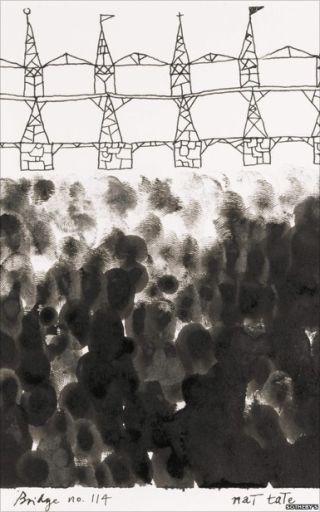Bridges From Nowhere

Nathwell Tate was born on or around March 7, 1928, in Union Beach, New Jersey — his official biography, “Nat Tate: An American Artist: 1928-1960,” isn’t quite sure about the date. As the book explains, that’s because Tate wasn’t very well known when he was alive. He was an artist who had some minor name recognition in New York art circles, and by and large, his paintings (often of bridges) were generally well received. But things turned dark for Nat Tate just as he began to see some success. He traveled to Europe and, seeing the quality of art there, decided his work wasn’t up the high standards he placed upon himself. He approached the people who had bought his artwork and asked to buy the pieces back, as he wanted to improve upon them. He was able to reacquire his entire collection but, as far as he was concerned, could not get his paintings to reach the quality of the greats he had seen in Europe. Instead, he destroyed the vast majority of his life’s work — perhaps as much as 99% of it. And then, tragically, he threw himself over the rail of the Staten Island Ferry, attempting to take his own life at age 31.
But don’t cry for Tate. He didn’t die that day. He didn’t die at all. He couldn’t have, because he never existed.
Tate was the creation of a novelist named William Boyd. Boyd was playing a prank on the NYC art scene, and started by writing the above-mentioned biography — making it up from scratch. On the night of March 31, 1998 — maybe that should have given it away? — Boyd threw a book launch party for himself. Among the guests who were in on the joke were rock star David Bowie (who was big in art circles at the time) and writer Gore Vidal; according to the BBC, Vidal even lent his name to an endorsement on the book’s dust jacket. Boyd’s goal was to give the inner circle of society a reminder that skepticism and cynicism is important — especially when, to a large degree, that audience is the one which determines what is art and what is not. By making the fictional Tate famous, Boyd hoped, he’d send that message. And, according to the a person who worked for Boyd’s publisher (per the BBC), the ruse worked: “people kept saying ‘Yes, I’ve heard of him’. There is a willingness not to appear foolish. Critics are too proud for that.”
And then, Tate became real. Well, real-ish. In order to make the con seem as real as possible, Boyd created a couple of paintings which, he claimed, were the recovered pieces of Tate’s collection. (After all, what’s an artist without artwork?) Over time, the fake artist’s fame, mostly stemming from the fact that Boyd’s prank was becoming increasingly well-known, created an interest in his work, amateurish as it was. On November 15, 2011, Sotheby’s — a real (and famous) auction house — put Tate’s “Bridge No. 114,” seen above, up for bid. Sotherby’s disclosed the history of the Tate story and the fact that the artist, to use the term loosely, was really Boyd. Nevertheless, Bridge No .114 sold for £7,000 to an anonymous buyer.
Bonus Fact: In 1975, David Bowie released the album “Station to Station,” which was critically acclaimed — a few decades later, Rolling Stone named it as one of the top 500 albums of all time. It sold well, too, reaching Gold status in early 1976. But ask Bowie about it what inspired him to produce such a masterpiece and he’ll likely give you a blank stare. As Wikipedia notes, “during the [recording] sessions Bowie was heavily dependent on drugs, especially cocaine, and recalls almost nothing of the production.”
From the Archives: The Pride of Georgia Tech: The graduate who didn’t exist.
Take the Quiz!: Can you recite all 207 words (including duplicates) of David Bowie’s 1969 hit “Space Oddity”?
Related: “Nat Tate: An American Artist: 1928-1960,” the book. 72 pages of total BS.
